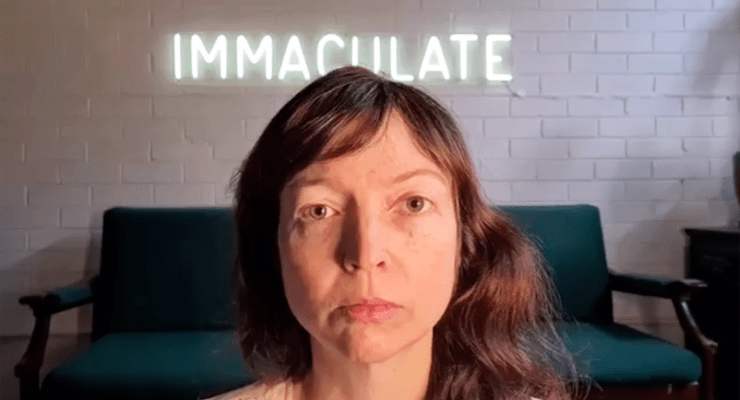
Creative Australia’s recent rebranding from what was once the Australian Council for the Arts seemingly came a little too soon. Last week the funding body — which oversees most of the major creative projects in Australia — had to settle a Federal Court case that included an extensive apology and a six-figure payout in damages to feminist performance artist Casey Jenkins.
To understand the implications of Jenkins’ victory, we need to rewind to the events that led to their court settlement.
In 2019 the Australia Council awarded Jenkins a grant of $25,000 to make an international artwork, but when COVID-19 lockdowns struck in 2020, the artist was obliged to reimagine the proposal. The revised artwork, approved by the Australia Council, was IMMACULATE: a serial video performance involving Jenkins artificially inseminating themselves in their home using donor sperm and reflecting on the experience as a single, queer parent.
While the performance, to be exhibited through the artist’s website, was intended as a quiet, meditative work, the media response starkly contrasted. Peta Credlin, Sky News host and former chief-of-staff to ex-PM Tony Abbott, condemned IMMACULATE, describing it as a “sheer abuse of taxpayer grants”. Other right-wing commentators such as Bella d’Abrera also expressed outrage and offence, which was echoed by a particular group of donor-conceived children.
The Australia Council soon rescinded Jenkins’s funding, stating: “We cannot be party to any act that could result in bringing a new life into the world.” At the same time, it sent Jenkins a transcript of Credlin’s criticism.
The Australia Council’s apology admitted to making misleading public statements about the work, including creating the impression that the insemination was illegal. The court determined that the Australia Council broke confidentiality agreements with the artist and made comments of a personal and discriminatory nature. It further admitted to threatening to penalise other funding bodies associated with the artist.
The apology is three years overdue. Over that extended period, Jenkins has claimed they have been unable to find spaces willing to exhibit their work in Australia, and the funding withdrawal has likely influenced the artist’s access to alternative financial support.
It is a significant win for Jenkins, especially as an artist who had to survive the pandemic as a single parent. To have their award rescinded during a time of financial hardship, on top of being publicly attacked, demonstrates the compounding intersectional punishments for those who do not conform to social norms.
Jenkins’s case shows that we now have a national arts body that is actively trying to shut down and defame artists. We should be deeply disturbed by this. Moreover, we should be alert to the fact that certain women’s bodies and reproductive choices in contemporary Australia are still considered potentially dangerous and subject to censorship.
Performance art has historically been provocative, pushing at the margins of society. It frequently creates uncomfortable and sometimes confronting spaces to explore and question the status quo. That’s why it remains one of the few spaces left for gauging our democracy.
If Creative Australia is nervous and reactive about art that depicts young, white, non-heteronormative bodies and behaviours, what might this mean for artists of colour, or those with disabilities, or older body-based artists? Will the outcome of this case make Creative Australia more risk-averse in future?
It begs the question, what role do we want art to play in Australian culture today?
If our taxpayer dollars only fund what is palatable to the majority or the mainstream, how will our culture ever grow and what does this say about the state of our democracy? In such a racially, culturally and religiously diverse nation, who is determining what is offensive to whom? If art doesn’t stretch and challenge us to think outside the habitual, why bother engaging with it at all?
Since Jenkins’s funding was rescinded, the government has changed, but the governing body of Creative Australia has not. If our artists feel pressured to play it safe, our nation won’t produce the next generation of artists like Uncle Jack Charles, Destiny Deacon, Mike Parr, Patricia Piccinini, Julie Rrap or Stelarc.
But maybe, thanks to Jenkins, Australian creatives might feel a little emboldened to express themselves without fear of retribution. This is the only way the future of the Australian arts can grow to be as vibrant, diverse and unique as the cultures it represents.
What do you think of the impact of artists such as Casey Jenkins? Readers, we want to hear from you — especially while our comments are closed due to our website upgrade. Send us your thoughts on this article to letters@crikey.com.au. Please include your full name to be considered for publication. We reserve the right to edit for length and clarity.








Crikey is committed to hosting lively discussions. Help us keep the conversation useful, interesting and welcoming. We aim to publish comments quickly in the interest of promoting robust conversation, but we’re a small team and we deploy filters to protect against legal risk. Occasionally your comment may be held up while we review, but we’re working as fast as we can to keep the conversation rolling.
The Crikey comment section is members-only content. Please subscribe to leave a comment.
The Crikey comment section is members-only content. Please login to leave a comment.